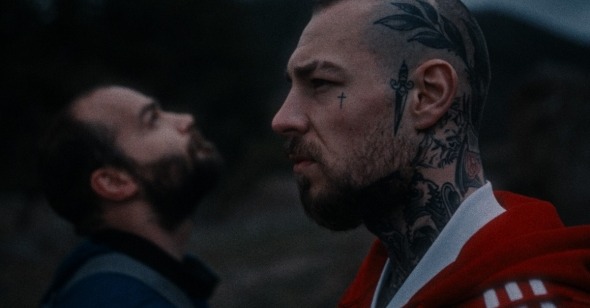Father Figure
By Savina Petkova
Windless
Dir. Pavel G. Vesnakov, Bulgaria/Italy. no distributor
Windless screens Saturday, March 15, at Museum of the Moving Image as part of First Look 2025.
In the United States, people refer to one’s country of origin as “homeland.” Europe’s linguistically gendered way of speaking, however, seeps into the act of naming: Russia, Turkey, and the UK use “motherland,” while others, like Bulgaria, prefer “fatherland.” This convention can easily be extrapolated to a paternal metaphor, prompting certain assumptions about Eastern Europe’s calcified patriarchal social order, but it also provides a key for Pavel G. Vesnakov’s sophomore feature, the minimalist father-son drama Windless. The father may be dead, but his absence is so pronounced that he becomes a presence.
The film begins as Kaloyan (Ognyan Pavlov) returns to his hometown from a settled life in Spain. Like every small-town boy who grew up to be an immigrant, he has a traumatic reason to visit: to clear out his late father’s flat and deal with the paperwork. But Kaloyan doesn’t look like every other man there—full-hand tattoos peek out of his sleeves, his face and head are all inked up, too. People keep commenting on his appearance, as if his brooding look and reticent demeanor aren’t enough to signal his difference. Not only that, but everyone he meets—relatives, acquaintances, townsmen, twice or three times his age—talk and talk, their stories endearing and humorous in a slightly ancient way. Kaloyan, though, keeps silent, as others regale him with anecdotes about the father he barely knew. “Why didn’t you come to his funeral?” one man asks him, and all he gets is a tight-lipped shake of the head.
Yet, those silences feel rather warm and intimate, like a dwelling place carved for oneself following years of isolation. Windless fleshes out a character that is brand-new to Bulgarian cinema—a young (alpha? masculine?) man whose quiet reckoning overcomes his defenses in a society that values “real men.” Vesnakov, who also wrote the film, knows better than to rely on words to mark this shift. Instead, he and his trusted cinematographer Orlin Ruevski opted for the extreme formalistic confinement of a 1:1 aspect ratio (also seen in Xavier Dolan’s Mommy) highlighting Kaloyan’s inability “to square” his perception of his dad with everyone else’s. At the same time, while the square ratio closes in on him as the film goes on, the otherwise stringently calibrated compositions offer some salvation. The first time we see Kaloyan, he is framed centrally, as a pronounced foreground, but his profile is out of focus in lieu of a rather unremarkable background.
As a whole, the visual style of Windless is rigorously pictorial with centrally composed shots and the linear perspective of Renaissance art, where the relative size, shape, and position of objects is organized around imagined lines converging at a point on the horizon. But even though the film upholds those conventions, it also makes room for the character to resist or break them, like in the opening image.
Tenderness and melancholy go hand in hand in Windless, and they are channeled through gestures and looks in Pavlov’s subtle performance—he speaks slowly and softly, subdued to the point of disinterest. Better known as Fyre, the 29-year-old Bulgarian rapper had a small role in Vesnakov’s debut feature, German Lessons, but here, as the quiet lead in a film about paternal trauma, he performs facets of troubled masculinity rarely seen on screen in his national cinema. Kaloyan is often off-screen, listening to others as they eulogize his late father—how he saved a man’s life during military service or helped a family in financial need—in single-take sequences showing only the person speaking. In another scene, the camera is placed in the back of a truck, while Kaloyan recounts a UFO sighting with his dad to a friend in the front, his voice disconnected from its source. In those set-ups, a sense of dislocation overpowers a simpler use of formalism—the viewer is simultaneously “in” and “out” of the story in the same way that Kaloyan is both invited in and cut off from the memories shared.
This sense of displacement haunts the film. Kaloyan’s whole life is in Spain (as is his concerned mother, whom we see over video calls), yet here he is, in this unnamed town burning old furniture, photographs, and Christmas decorations from the Soviet Union. Since the town itself is undergoing some of its own developments: apartment buildings are getting sold, casinos are being built, and the old cemetery is being moved to make space for a golf course. What remains of the past in the confluence of time and capital?
Windless is a film about remembering, but one free of nostalgia and longing. Even if the gap between Kaloyan and his late father can be stretched to the point of becoming a metaphor for the generations before and after 1989, when the fall of the Berlin Wall accelerated Europe’s preoccupation with post-memory in order to revisit personal and political traumas, Vesnakov’s script avoids didacticism. Moral verdicts and lessons in parenting have no place in this film—instead, the film holds space for the silences that substitute articulated feelings. But there is more to those deferrals, stand-ins, and metaphors for paternal absence—there is rawness and optimism in the way Windless paints a double portrait: of a son’s past disappointments and of the man he hopes to be.
